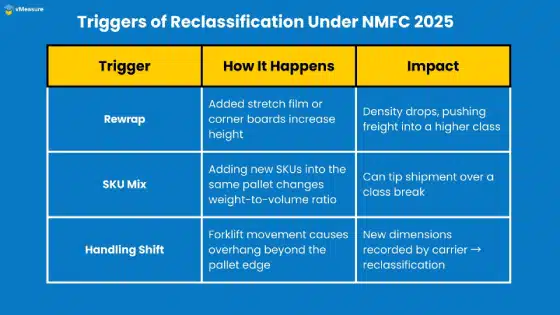NMFC Docket 2025-1 has shifted the balance: the initial measurement and the data you submit can be challenged at any time. Carriers now expect every shipper to prove that their records are accurate and verifiable.
How does Docket 2025-1 change the freight audit?
Why are mid-cycle audits the real disruptor?
Why is “audit readiness” the new baseline?
- Your first scan holds up against carrier verification.
- Your measurement source is trusted, not just convenient.
- Your records are instantly retrievable, not scattered across systems.
How do you prove audit readiness without repeating past mistakes?
- Alignment with carrier records: Do your first scans match what carriers enter, down to fractions of an inch?
- Single source of measurement truth: Can you point to one verified system, or are you still juggling spreadsheets, WMS logs, and manual notes?
- Speed of retrieval: When finance or a carrier asks for proof, is it instantly available, or do you spend hours stitching files together?
What are the hidden costs of being unprepared?
- Opportunity cost: Carriers hesitate to offer favorable terms if your records are questionable.
- Team cost: Finance and ops waste hours reconstructing files instead of managing freight.
- Reputation cost: Getting flagged as “high risk” affects negotiations long after the audit.
What role do pallet dimensioning systems play?
They capture accurate dimensions at the dock, integrate them directly into your WMS or TMS, and tag each record to the shipment ID. When auditors ask for proof, you don’t dig through old files; you export a verified record that aligns with the carrier’s own system. That is how audit readiness scales.
The table below highlights the most common audit readiness gaps and how automation closes them, turning weak links that once triggered disputes into verifiable proof.

What should shippers do now to avoid audit surprises?
- Automate measurement at the dock so every shipment starts with verifiable data.
- Integrate systems so measurement, weight, and class flow together instead of living in silos.
- Set retrieval SLAs internally so proof is always a click away.
With automated pallet dimensioners like vMeasure, every first scan becomes proof that’s already ready when the carrier asks. Not next week, not after hours of digging, right when it counts. That’s how you stay audit-ready in a post-Docket 2025-1 world, and the shippers who make it standard today will be the ones setting the pace tomorrow.